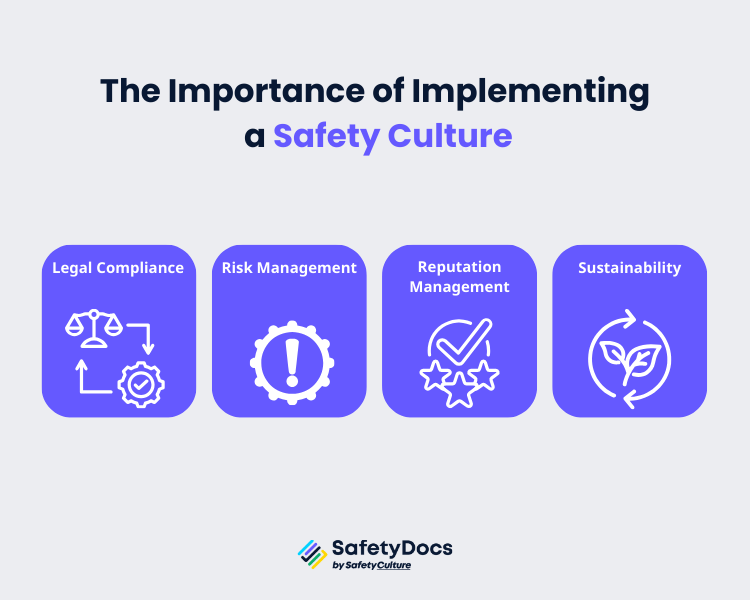According to the 2023 Key Work Health and Safety (WHS) Statistics, workplaces have witnessed more than 1,850 fatalities and 1,140,000 serious compensation claims over the past decade. Although there has been progress in enhancing workplace safety, the data indicates that further efforts are required.
One crucial step is fostering a strong safety culture, an essential aspect beyond mere compliance with regulations. Safety goes beyond rules; it's a way of life. Safety culture goes beyond compliance, creating an environment where safety is ingrained in every aspect of an organisation. In this blog, we'll explore the benefits and importance of implementing a safety culture in an organisation.
What is a Safety Culture?
Safety culture refers to the comprehensive approach to managing safety within a workplace. It encompasses the collective beliefs, perceptions, and attitudes of employees towards the well-being of workers and the overall safety of the work environment. It plays a crucial role in maintaining a safe workplace. It can influence human performance in safety-related tasks, affecting the organisation's safety performance.
Key Attributes of a Strong Safety Culture
Leadership Commitment
The foundation of any successful safety culture is strong leadership commitment. Leaders can establish the atmosphere and direction for the entire organisation. This commitment trickles down, influencing every employee and creating a shared responsibility for safety.
Employee Involvement
Safety is a collective effort. When employees actively participate in safety initiatives, they become stakeholders in the organisation's and their colleagues' well-being. Involvement can range from reporting hazards to actively engaging in safety committees.
Open Communication
Effective communication is the backbone of safety culture. Encouraging open dialogue ensures everyone feels comfortable to report errors or suggest improvements without fear of reprisal. This cultivates a proactive mindset towards safety, emphasising the importance of preventive measures.
Continuous Improvement
A safety culture is dynamic and constantly evolving to address emerging risks. Continuous improvement involves reassessing procedures, incorporating feedback, and staying abreast of industry advancements to enhance safety protocols.
Work Design and Environment
The physical aspects of the work environment, such as layout and equipment design, play a significant role in maintaining safety. A strong safety culture involves considering these factors when designing work processes.
Staffing and Workload Safety Management
Organisations must ensure that employees have the necessary skills, and knowledge to perform their tasks safely. This includes proper staffing and workload safety management to mitigate fatigue and stress-related risks.
Examples of a Safety Culture
Here are some examples of companies demonstrating excellent safety cultures:
- Leading by Example: Senior management is crucial in establishing an effective safety culture. They enforce safety protocols and embody them in their daily activities. This leadership support fosters a culture where safety is prioritised at all levels.
- Emphasis on Quality and Teamwork: A strong safety culture places great importance on the quality of work and teamwork. Workers are encouraged to collaborate and communicate effectively to prevent errors and accidents. There's an understanding that everyone has shared responsibility, which promotes a sense of unity and mutual respect among employees.
- Non-Punitive Response to Errors: In a positive safety culture, mistakes are seen as opportunities for learning and improvement rather than occasions for punishment. This approach encourages employees to report errors, incidents, and near misses without fear of reprisal, allowing the organisation to promptly and effectively address potential hazards.
- Proactive Safety Behaviours: Examples of proactive safety behaviours include wearing personal protective equipment (PPE) without being asked and completing risk assessments for all jobs. These behaviours demonstrate an ingrained commitment to safety beyond mere compliance with rules and regulations.
Benefits of a Strong Safety Culture
Increased Productivity
Contrary to the misconception that safety measures slow down productivity, a strong safety culture enhances it. Workers who feel safe and supported are more focused, efficient, and productive.
Minimising Costs
Safety incidents can be expensive, from medical bills and compensation to regulatory fines and legal fees. Poor safety culture can also lead to compensation claims and damage a company's reputation. Taking the necessary steps to ensure safety can significantly minimise costs in the long run.
Improved Employee Morale
Employees who feel appreciated and valued are more likely to be motivated and engaged. A strong safety culture fosters a positive work environment, improving employee morale and overall job satisfaction.
Enhanced Reputation
Organisations with a demonstrated commitment to safety can hire top talent and gain a competitive edge. Customers and stakeholders also prefer companies with a strong safety culture, enhancing the organisation's reputation.
These benefits highlight the vital role of safety culture in an organisation's success. It's an investment that pays off in the long run, making it necessary for all organisations to prioritise.

Challenges in Building a Culture of Safety in the Workplace
While the benefits of a safety culture are significant, implementing and maintaining it is challenging. Some common obstacles include:
Resistance to Change
Resistance to change is a common hurdle in establishing a safety culture. Addressing this requires effective communication, leadership support, and demonstrating the positive impact of the changes on both individuals and the organisation.
Lack of Resources
Limited resources can impede the implementation of safety culture initiatives. However, creativity and prioritisation can help organisations make significant strides with the available resources, emphasising the importance of safety.
Overcoming Challenges
Every challenge presents an opportunity for growth. Overcoming challenges in building a safety culture involves adaptability, learning from setbacks, and continuously refining strategies based on evolving circumstances.

Importance of Implementing a Safety Culture
Even with challenges, implementing a safety culture is crucial for:
Legal Compliance
Prioritising safety culture ensures organisations comply with local, regional and international regulations, avoiding legal safety issues and penalties while promoting overall safety culture.
Risk Management
A strong safety culture involves identifying and managing risks before they turn into incidents. This proactive approach minimises the chances of accidents and injuries, protecting employees and assets.
Reputation Management
Reputation in a workplace pertains to the public's perception of an organisation, its products, services and core values. Demonstrating a positive safety culture can enhance the organisation's reputation and positively influence business.
Sustainability
A safety culture is an investment in the long-term sustainability of an organisation. Prioritising employee well-being and creating a safe work environment fosters trust, loyalty, and commitment among employees, leading to greater productivity and success.
Measuring Safety Culture in the Workplace
Implementing is one thing, but to measure and to assess safety culture is another. Some common methods for evaluating safety culture include:
- Safety Perception Surveys: Surveys gather employee perceptions and attitudes towards safety in the workplace. It provides valuable insights into areas that require improvement and employee satisfaction with safety protocols.
- Safety Culture Assessment: A safety culture assessment evaluates how employees behave, react and interact with each other regarding health and safety.
- Incident Reporting and Analysis: Tracking incidents, near misses, and their root causes can identify safety gaps and inform improvement strategies. Regularly analysing this data helps identify patterns and trends, guiding proactive measures.
- Interviews and Focus Groups: These methods provide in-depth insights into employees' perceptions and experiences. They can help identify strengths and weaknesses in the organisation's safety culture that may not be apparent through surveys alone.
- Safety Metrics: Key metrics can include the ratio of employee hours to worked hours, the pass rate of training competency evaluations, and the number of reported safety incidents. However, it's important to remember that these metrics should be used as part of a broader evaluation and not relied upon exclusively.
- Observations: Observing employees' behaviour can provide valuable information about the organisation's safety culture. This can include observing whether employees use safety equipment properly, how they respond to potential hazards, and how they interact with each other about safety.
- Benchmarking: Comparing your organisation's safety performance with other similar organisations can provide a helpful benchmark. This can help identify areas where your organisation is doing well and where there is a poor safety culture.

Ways to Implement Safety Culture
So, how can an organisation implement and maintain it? Here are ways to get started:
Training Programs
Educating employees about safety practices is fundamental. Training programs should be comprehensive, addressing specific job-related risks and providing tools to mitigate them. Ongoing education ensures that safety remains a priority.
Safety Policies
Clear and concise safety policies create a framework for expected behaviours. These policies should be communicated effectively, and adherence should be consistently reinforced through positive reinforcement and, when necessary, corrective measures.
Safety Audits
Regular safety audits are essential to identify and rectify potential hazards. These audits should involve employees at all levels and aim to continuously enhance health and safety protocols based on real-world observations and feedback.
Safety Committees
Safety committees comprising representatives from all levels of the organisation can provide valuable insights and recommendations for improving safety. These committees should meet regularly, discuss safety concerns, and develop strategies to address them.
Safety Protocols
Safety protocols should be developed, documented, and communicated effectively. This includes procedures for handling incidents, communicating safety information, and ensuring compliance with safety regulations.
We Make Implementation Easier
SafetyDocs by SafetyCulture is Australia's most trusted provider of safety documents, including templates, checklists, and forms. These resources help organisations create and maintain a safety culture, making implementation more manageable. With SafetyDocs, you can:
- Access a Wide Range of Resources: SafetyDocs offers hundreds of templates and checklists to assist in creating and maintaining a safety and health culture in the workplace.
- Customise Documents to Meet Your Needs: Customise templates and documents based on your organisation's requirements.
- Stay Updated with Regulations: SafetyDocs regularly updates its resources to align with the latest safety regulations, ensuring legal compliance.
Browse from our library of safety documents and start implementing a culture of safety in your workplace:
- Safe Work Method Statement (SWMS) Templates
- Standard/Safe Operating Procedure (SOP) Templates
- Safety Management Plans
- Checklists, Forms & Registers
Contact SafetyDocs today to learn more about how we can help you create a positive safety culture in your workplace.
Our team of experts is dedicated to providing accurate and informative content. Craig Cruickshank, our senior HSEQ advisor at SafetyDocs by SafetyCulture has reviewed this blog post to ensure the highest level of quality.
Learn more about Craig's work on LinkedIn for more industry insights.
Available for instant download and supplied in fully editable MS Word format for use in your business.
Please note that the above information is provided as a comment only and should not be relied on as professional, legal or financial advice.
Share This Article
